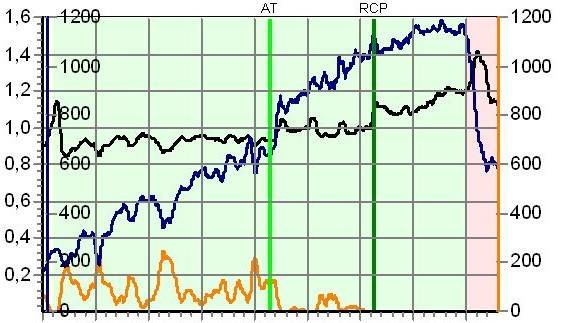Den Begriff des respiratorischen Quotienten aus der Spiroergometrie, der Atemgasanalyse während einer Belastung, hat man vielleicht schon mal gehört, aber was versteht man eigentlich darunter und welche Bedeutung besitzt er? Um dies zu verstehen muss man die Spiroergometrie ein wenig genauer betrachten.
Während einer Spiroergometrie werden anhand einer Atemmaske während einer Belastung (meistens auf dem Fahrradergometer bzw. Laufband) die ein- und ausgeatmeten Atemgase analysiert (O2 und CO2), sowie die Atemvolumen (V für Volumen) gemessen. Dies geschieht heutzutage mit so genannten breath by breath Systemen, die in der Lage sind jeden einzelnen Atemzug zu analysieren.
Differenzierte Terminologie
Unter dem Respiratorischen Quotienten versteht man das Verhältnis des abgegebenen Kohlendioxids (VCO2) zu aufgenommenen Sauerstoff (VO2) während des gesamten Atemzyklus. Genau genommen steht der Respiratorischer Quotient (RQ) für die innere Atmung in der Zelle (Stoffwechsel), deshalb spricht man auch von der Respiratory Exchange Rate (RER) als Bezeichnung für die äußere Lungenatmung, die man mit der Spiroergometrie misst. Warum man dies unterscheiden muss werden wir uns später anschauen.
Fette oder Kohlenhydrate?
Anhand der Respiratory Exchange Rate kann man während einer Belastung, oder auch während der Ruhe (Grundumsatzmessung) exakt berechnen, wie viele Fette oder Kohlenhydrate bei welcher Belastungsintensität verbrannt werden. Dies funktioniert über das Wissen, dass Fette, Eiweiße und Kohlenhydrate unterschiedliche RER Werte liefern:
Fette: 0,7
Eiweiße: 0,8
Kohlenhydrate: 1,0
Diese Verhältnisse kommen aus der Biochemie und entstammen den jeweiligen Reaktionsgleichungen und den VCO2 und VO2 Verhältnissen. Anhand dieser Zahlen kann man die tatsächlichen Fettverbrennungs- und Kohlenhydratverbrennungsraten berechnen. Somit ist eine Beurteilung des Energiestoffwechsels möglich.
Grenzen und Einflußfaktoren auf den RER
Wie bereits angesprochen muss man den RQ und den RER genau genommen unterscheiden, da der Stoffwechsel im Körper (während der Belastung) nicht immer dem RER (die gemessenen Werte für VCO2 und VO2 über die Atemmaske) entspricht. Der RER entspricht bis zu einer bestimmten Belastungsintensität dem Stoffwechsel im Körper. Dies ist genau bis zu dem Punkt der Fall, bis im Körper aufgrund der gestiegenen Belastungsintensität die Laktatpufferung einsetzt und Exzess-CO2 abatmet wird. Bis zu diesem Zeitpunkt kann man den Energiestoffwechsel sinnvoll berechnen, darüber hinaus nicht mehr.
Zudem gibt es verschiedene Einflußfaktoren auf den RER
- Ernährungsverhalten vor dem Test
- Glykogenspeichergröße
- Atemtechnik (Hyper- und Hypoventilation)
Das Ernährungsverhalten beeinflusst den RER, da die Gabe von einfachen Kohlenhydraten den Insulinspiegel erhöht und der Körper automatisch auf die energetisch günstigeren Kohlenhydrate zurückgreift. Im umgekehrten Sinne täuschen entleerte Glykogenspeicher einen guten Fettstoffwechsel vor, der eigentlich nicht vorhanden ist.
Zusammenfassend kann man sagen, dass der RER respektive RQ unter Beachtung einer standardisierten Vorbereitung auf einen Test zur Beurteilung des Energiestoffwechseln im unteren Belastungsbereich und der Grundumsatzmessung herangezogen werden kann, aber nicht überbewertet werden sollte und immer differenzialdiagnostisch betrachtet werden muss.




















